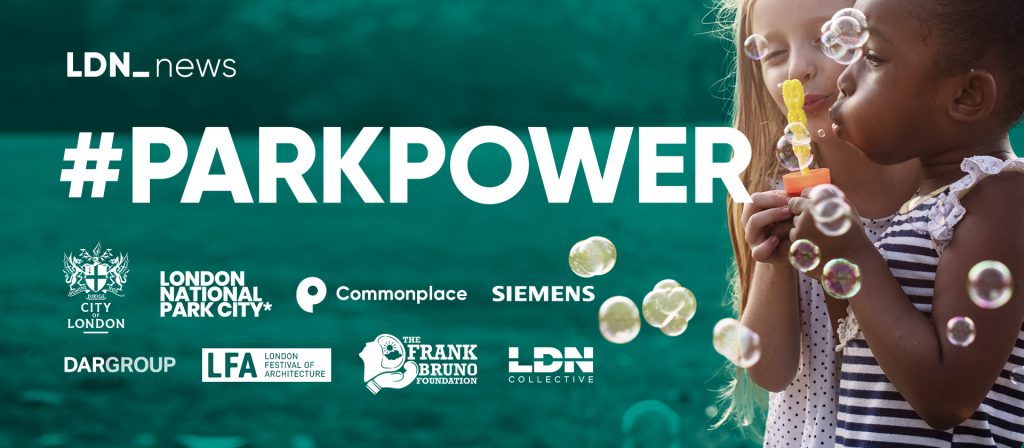
Ying Tan, Head of Public Art (Interim) at Futurecity interviews Samantha Paul, Associate at SpaceHub and member of The London Collective, on organising the digital sharing initiative #ParkPower. As the second instalment of Digital Dialogues, a series in which Futurecity interviews cultural and property innovators to reveal the complexity of collaborators and client teams involved in digital place-shaping process, we ask people to engage in this online effort.
Ying Tan:
Can you tell us a bit more about The London Collective and its role in organising #ParkPower?
Samantha Paul:
The London Collective is a virtual network of built environment experts and creatives fighting hard to improve people’s lives and the planet’s prospects. As self-employed entrepreneurs we tailor-make teams without the overheads, convening and disbanding for place-based projects like a film’s cast and crew. We have landscape architects like ourselves as well as cultural placemaking experts like Futurecity. Our strength comes from diversity and collaboration, as well as an incredible network to tap.
The #ParkPower project is a collaboration between a diverse group of organisations, who were brought together by the London Collective. The first stage is underway, to crowdsource community feedback, before we use them to inform designs. We are asking as many people as possible visit the website and tell us what they love about their local park and their ideas for the future. The aim is to create a source of evidence to develop future concepts, including designs and recommendations, for a collective vision of the future for London’s parks and green spaces. Whilst we cannot promise that all of the ideas will be implemented, we will be working with partners to develop designs that can help these places become even more valuable and ‘future proofed’.
Ying Tan:
How did the partnership with London Festival of Architecture’s come about in the #ParkPower project?
Samantha Paul:
The London Festival of Architecture is a great platform to experiment and test visionary ideas and thinking. It enabled us to reach out to a number of different partners including the City of London Corporation, who own parks and commons from Hampstead Heath to Epping Forest, the urban design teams of the London Collective and Dar Group, Siemens Smart Infrastructure, London National Park City, the online community engagement platform Commonplace and the mental health charity the Frank Bruno Foundation. All of whom bring different perspectives and are committed to making our parks more resilient and multi-functional places.
Ying Tan:
What do you hope to achieve with the #ParkPower initiative, how might it engage audiences to reimagine parks?
#ParkPower is a timely initiative that offers the opportunity to harness this renewed collective appreciation of our local parks. The platform offers the opportunity for anyone to contribute and inform the future of these green spaces. With London confirmed as the world’s first National Park City in July 2019, with the aspiration for making the city greener, healthier and wilder, #ParkPower is a tool to enable inclusive co-design. Our parks are ultimately only as successful as they are used and the end user is the ultimate client. Londoner’s have tried and tested all aspects of our green spaces and #ParkPower allows everyone’s feedback to be recorded for future improvement. As a landscape architect, this is an invaluable insight in addition to traditional public engagement.
Ying Tan:
How might this initiative steer the conversations around public space and public realm within cities?
Samantha Paul:
Not everyone uses parks in the same way. #ParkPower allows an insight to the many different ways parks are enjoyed, or indeed an understanding of where they fall short. As a landscape architect it allows us to ‘cast our net’ wider, to design more inclusively, creating parks informed by many.
Armed with crowd sourced intelligence, there is never one way to design a park, but ten good ways, as long as the key ingredients respond to the same things- wellbeing, microclimate, safety, sustainability, function, ecology, programme and legacy to name a few.
Ying Tan:
What do you see as the legacy of #ParkPower and how might this work be taken forward in the future?
Samantha Paul:
At a time when a climate emergency has been declared and a global pandemic has pushed the value of our local parks up the agenda, #ParkPower is a platform that will help guide the future of our green spaces from a local perspective. All the green spaces in London’s National Park need to be safeguarded but also adaptive for the future. Increased temperatures, drought, biosecurity threats to increased population mean we need a holistic strategy to safeguard our parks, but from a collaborative, bottom up approach.
The #ParkPower legacy offers a new outlet for understanding local lived experiences that can become decision making tools to inform the future vision of our parks.
See Futurecity London choices: @futurecityblog
Image: Spacehubs proposals for an elevated park at Bishopsgate Goodsyard. (c)FaulknerBrowns Architects
